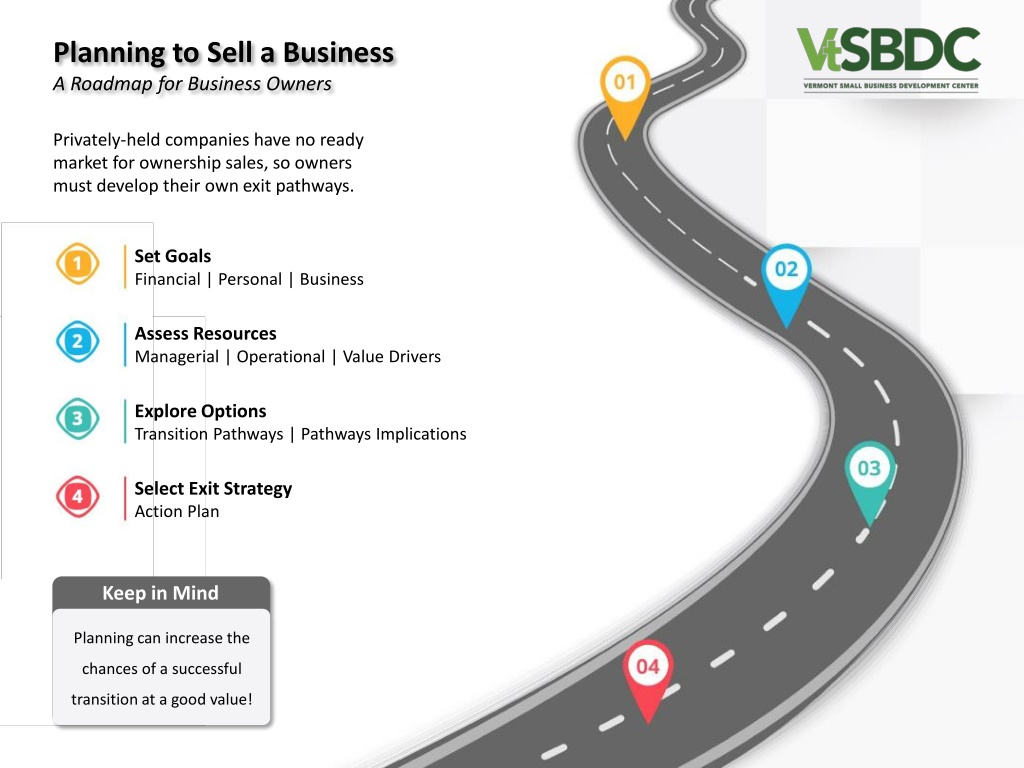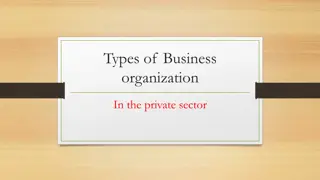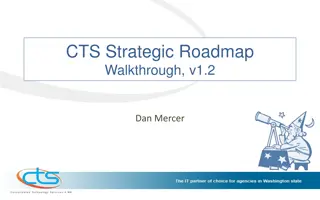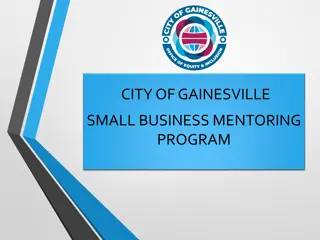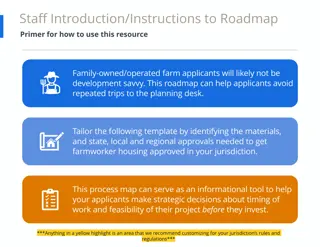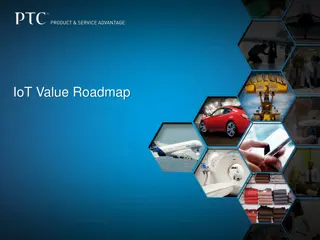Roadmap for Selling a Business: A Guide for Private Company Owners
Privately-held companies often lack a ready market for ownership sales, requiring owners to create their own exit strategies. This roadmap outlines the steps, from setting goals to selecting an exit strategy, to increase the chances of a successful and lucrative transition. Business advisors play a crucial role in navigating the complexities of selling a business, addressing factors like financial health, operational efficiency, and market attractiveness. Planning can enhance the value of the business, reduce tax liabilities, and ensure a smooth transition for both the owner and potential buyers.
Download Presentation

Please find below an Image/Link to download the presentation.
The content on the website is provided AS IS for your information and personal use only. It may not be sold, licensed, or shared on other websites without obtaining consent from the author. Download presentation by click this link. If you encounter any issues during the download, it is possible that the publisher has removed the file from their server.
E N D
Presentation Transcript
Planning to Sell a Business A Roadmap for Business Owners Privately-held companies have no ready market for ownership sales, so owners must develop their own exit pathways. Set Goals Financial | Personal | Business Assess Resources Managerial | Operational | Value Drivers Explore Options Transition Pathways | Pathways Implications Select Exit Strategy Action Plan Keep in Mind Planning can increase the chances of a successful transition at a good value!
Planning to Sell a Business A Roadmap for Business Owners Assess Resources Select Exit Strategy Set Goals Explore Options Introduction Why Planning | Roadmap vs GPS | What Buyers Want WHY PLANNING? ROADMAP vs GPS WHAT BUYERS WANT Business pre-sale planning is indispensable Use this material with a business advisor Buyers want businesses with: Strong revenue and profits Sound financial condition Well-structured processes and capabilities Facilities and equipment in good standing Well-trained and right-sized staff Diversified client base Attractive location Pristine legal condition Strong brand and reputation Growing market in growing/stable industry Easy transferability to new owners Planning is an opportunity to involve your team, spot inefficiencies, and improve operations to increase the value of the business. This material is your roadmap. A roadmap shows you all the possibilities. It does not take into account your business context. A business advisor is your GPS. A GPS helps you take the best route in the roadmap. The business advisor will add context to help you navigate the process and get the most out of your effort. Planning can increase your chances of success Private companies have no ready market for ownership sales. Business owners must develop their own exit pathways. Planning may increase the chances of selling at a good value. Planning may also reduce tax liabilities to net more sales proceeds. In addition, planning will help to shift operating focus to boost saleability and price. Business advisors = Decision-making partners Planning to sell a business involves a whole host of critical decisions that can have a life- long impact. These may be decisions a business owner never made before. The sheer volume of new decisions can be overwhelming and that can impair the ability to think clearly. Business advisors help business owners to achieve sound decision-making. In addition, buyers may be seeking to buy a business in a specific market area or in a specific industry. Planning gives structure and peace of mind Planning serves to improve the gaps in the business and show buyers the business attributes they want to see. That will help attract the right kind of buyer for the business. Selling a business can be lengthy and anxiety producing. Planning helps to clarify the steps along the way. In turn, clarity allows business owners to be calm and patient. Business advisors = Accountability partners Planning to sell a business requires shifting management focus. Old focus: run the business. New focus: increase business value. Business owners may tend to drift back to the old focus . Business advisors help business owners to stay on track. 1
Planning to Sell a Business A Roadmap for Business Owners Assess Resources Select Exit Strategy Set Goals Explore Options Set Goals Financial | Personal | Business KNOW WHAT YOU WANT 1.2) PERSONAL GOALS Define your motivations and objectives for selling the business Evaluate your financial hopes and expectations for the business exit Consider what is driving your need or desire to sell the business Assess your timeframe and how much urgency/flexibility you have Reflect on your desire to exit immediately or to stay in the business (work in some other capacity, or part-time, etc.) Consider any conditions for how the business should operate post-sale What is your desired personal life outcome from selling the business? Are your family and trusted friends aware of your plans to sell it? What is their reaction? What will you do with your extra free time after the business is sold? How will this extra free time impact your personal and family life? Are your personal goals aligned with your financial goals? QUESTIONS TO CONSIDER 1.3) BUSINESS GOALS 1.1) FINANCIAL GOALS How do you wish the business to live on without you as the owner? What is your desired outcome from the business sale for employees? Do you want any guarantees for your employees from a buyer? Is it important for the business to continue in the community? Is the business reputation and legacy important to you? Do you want any guarantees for the usage of the brand name? e.g. if the business carries your family name for many generations Do you know your personal cost of living? Do you have a household budget? What are your needs for future income after selling the business? Do you currently have other sources of income? Do you expect to have other sources of income in the future? How much should the business be sold to meet your future needs? Are you planning to start another business after selling this one? Do you have a financial planner or a financial advisor to work with? Do you have a CPA to assess the tax impact of selling the business? Define your timeframe: Do you have a timeframe for selling the business? 1, 5, or 10 years? The ideal timeframe to sell a business is up to 5 years Depending on the business and its situation, it can be a shorter/longer If you are planning to retire: What is your planned date of retirement? Does your timeframe have some flexibility? Do you plan or need to continue working after selling the business? How much will you get from social security/retirement plan/pension? CONSIDER GOALS TRADE-OFFS Highest possible price: may prevent immediate departure, all-cash at closing, post-sale conditions or involvement All-cash at closing: may prevent immediate departure, immediate sale, highest possible price Immediate sale: may prevent highest possible price, immediate departure Immediate departure: may prevent highest possible price, all cash at closing Post-sale conditions or involvement: may prevent highest possible price 2
Planning to Sell a Business A Roadmap for Business Owners Assess Resources Select Exit Strategy Set Goals Explore Options Assess Resources Managerial | Operational | Value Drivers KNOW WHAT IS POSSIBLE Human Resources Job descriptions for every employee Staff list with hire dates, salaries, employment contracts, benefits Employment policy manual and organizational chart Sales & Marketing Client list and major client contracts Products and service descriptions with price lists Marketing plan and samples of marketing materials Digital assets documentation (website, social media accounts, etc.) Financial Financial statements and tax returns for YTD and past 2-3 years Financial ratios, trends, and analysis of each product gross margin Accounts payable and accounts receivables aging reports Inventory list with value/aging detail and asset depreciation schedule Outstanding loan agreements and description of liens Your business resources determine its desirability and value The better the resources, the higher the desirability and value Well-established resources facilitate business transfer to new owners QUESTIONS TO CONSIDER 2.1) MANAGERIAL RESOURCES Is your staff trained and ready to cover your key responsibilities? What are their abilities and key skills? Are there new management successors prepared and committed? Do the owner/operator(s) have a written job description? 2.2) OPERATIONAL RESOURCES ARE THE FOLLOWING DOCUMENTS AVAILABLE & UP TO DATE? Operations Standard Operating Procedures or business operating manual Industry safety standards or certifications (e.g. ISO) All equipment lease and maintenance agreement/schedule/logs List of suppliers and distributors contacts with payment terms Intellectual Property: proof of patents, trademarks, other IP Business Business plan with business photos Business formation, registration, licenses, permits, certifications List of opportunities for improvement with financial projections Lease for building, office, equipment, and other asset Insurance policies List of fixtures, furnishings, and equipment with value detail 2.3) VALUE DRIVERS What is the estimated value of your business? Is your staff cross-trained to cover various functions? Is your customer base well established and transferable? Are your financials showing a history of revenue growth? Is there a consistent profitability every year with no major swings? Are there well-established business processes? Are the financial records in good standing and up to date? Does the business have a well-known and positive image? Are your contracts and leases transferable and of sufficient length? Is the business free of legal issues? Are your facilities and equipment in good standing? Do you have an established and transferable supplier base? Are your marketing investments outperforming industry KPIs? 3
Planning to Sell a Business A Roadmap for Business Owners Assess Resources Select Exit Strategy Set Goals Explore Options Explore Options Transition Pathways | Pathways Implications COMPROMISE WANTS WITH POSSIBILITIES Partially selling the business to a key employee or new co-owner Is a phased approach for the business exit a viable alternative? Are you willing to stay longer in the business with less responsibility? Does it make financial sense to sell part today and part in the future? Different buyers attribute different value to the same business Some business exit pathways will be more valuable than others Each pathway will provide a different outcome Assessing pathways helps you determine the best route for you Selling the business to another business or competitor Are you connected in your industry? Do you know your competitors? Any competitors who would benefit from having your business? Competitors may offer a better deal due to synergies! QUESTIONS TO CONSIDER Partially selling the business to another business or competitor Again, is a phased approach for the business exit a viable alternative? Are you willing to be a minority owner if that is required? How do you feel if you have to give-up control of the business? 3.1) TRANSITION PATHWAYS HAVE YOU CONSIDERED: Selling your part of the business to an existing partner? Selling the business to a key employee? Partially selling the business to a key employee or new co-owner? Selling the business to another business or competitor? Partially selling the business to another business or competitor? Transitioning to next-generation family members? Selling to all employees as a group (Coop or ESOP)? Selling to an individual buyer? Liquidating? Transitioning to next-generation family members Is it important for you to keep the business in the family? What about the conflict: high sale price vs future generation success? Did you consider estate planning, taxes, non-active family members? Are you willing to hire a Family Business Transition expert? Do you have a lawyer and a CPA to advise you? Are you willing to owner-finance part or the entire deal? Selling to all employees as a group (Coop or ESOP) Is business legacy and employee ownership important to you? Do you have enough employees to own it as a worker cooperative? Do you have 15+ employees and $10M+ in revenue for an ESOP? 3.2) PATHWAYS IMPLICATIONS Selling your part of the business to an existing business partner Do you have partner(s) capable of taking over your responsibilities? Do you have a partner buyout agreement in place? Will that have an adverse impact on your staff or overall business? Selling the business to a key employee Is there a key employee accepted by all staff and ready to take over? Do you need to groom a key employee? (that takes time!) Does the key employee have cash and collateral for bank financing? Selling to an individual buyer How much does the business depend on your work and skills? How easy/hard it is for anyone to take over your role as an owner? What skills does this individual must have to succeed? Liquidating If none of the above paths are viable, are you willing to liquidate? How much are you willing to accept for the business assets? 4
Planning to Sell a Business A Roadmap for Business Owners Assess Resources Select Exit Strategy Set Goals Explore Options Select Exit Strategy Action Plan 2.1) MANAGERIAL RESOURCES List all required actions to improve managerial resources 3.1) TRANSITION PATHWAYS List your preferred transition pathways in order of priority CREATE & FOLLOW AN ACTION PLAN Compile and organize your findings List the needed actions to guide next steps This is your pre-sale work summary _____________________________________ _____________________________________ _____________________________________ _____________________________________ _____________________________________ _____________________________________ _____________________________________ _____________________________________ _____________________________________ _____________________________________ _____________________________________ _____________________________________ _____________________________________ _____________________________________ 1.1) FINANCIAL GOALS List your financial goals List pers. finances required actions _____________________________________ _____________________________________ _____________________________________ _____________________________________ _____________________________________ 2.2) OPERATIONAL RESOURCES List all required actions to improve operational resources 3.2) PATHWAYS IMPLICATIONS List all required actions to address each listed pathway implication _____________________________________ _____________________________________ _____________________________________ _____________________________________ _____________________________________ _____________________________________ _____________________________________ _____________________________________ _____________________________________ _____________________________________ _____________________________________ _____________________________________ _____________________________________ _____________________________________ _____________________________________ _____________________________________ 1.2) PERSONAL GOALS List your personal goals List all personal life required actions _____________________________________ _____________________________________ _____________________________________ _____________________________________ _____________________________________ 2.3) VALUE DRIVERS List all required actions to improve aspects that increase business value 4) PRIORITIZE Assign a priority (1 to 7) to act: _______ Financial goals _______ Personal goals _______ Business goals _______ Managerial resources _______ Operational resources _______ Value Drivers _______ Pathway implications 1.2) BUSINESS GOALS List your business goals List all business life required actions _____________________________________ _____________________________________ _____________________________________ _____________________________________ _____________________________________ _____________________________________ 5 _____________________________________ _____________________________________ _____________________________________ _____________________________________
Planning to Sell a Business A Roadmap for Business Owners Assess Resources Select Exit Strategy Set Goals Explore Options Select Exit Strategy Action Plan ADDITIONAL NOTES ADDITIONAL NOTES ADDITIONAL NOTES _____________________________________ _____________________________________ _____________________________________ _____________________________________ _____________________________________ _____________________________________ _____________________________________ _____________________________________ _____________________________________ _____________________________________ _____________________________________ _____________________________________ _____________________________________ _____________________________________ _____________________________________ _____________________________________ _____________________________________ _____________________________________ _____________________________________ _____________________________________ _____________________________________ _____________________________________ _____________________________________ _____________________________________ _____________________________________ _____________________________________ _____________________________________ _____________________________________ _____________________________________ _____________________________________ _____________________________________ _____________________________________ _____________________________________ _____________________________________ _____________________________________ _____________________________________ _____________________________________ _____________________________________ _____________________________________ _____________________________________ _____________________________________ _____________________________________ _____________________________________ _____________________________________ _____________________________________ _____________________________________ _____________________________________ _____________________________________ _____________________________________ _____________________________________ _____________________________________ _____________________________________ _____________________________________ _____________________________________ _____________________________________ _____________________________________ _____________________________________ _____________________________________ _____________________________________ _____________________________________ _____________________________________ _____________________________________ Expand the notes from the previous page ADDITIONAL NOTES _____________________________________ _____________________________________ _____________________________________ _____________________________________ _____________________________________ _____________________________________ _____________________________________ _____________________________________ _____________________________________ _____________________________________ _____________________________________ _____________________________________ _____________________________________ _____________________________________ _____________________________________ _____________________________________ _____________________________________ _____________________________________ _____________________________________ _____________________________________ _____________________________________ _____________________________________ _____________________________________ _____________________________________ _____________________________________ _____________________________________ 6
